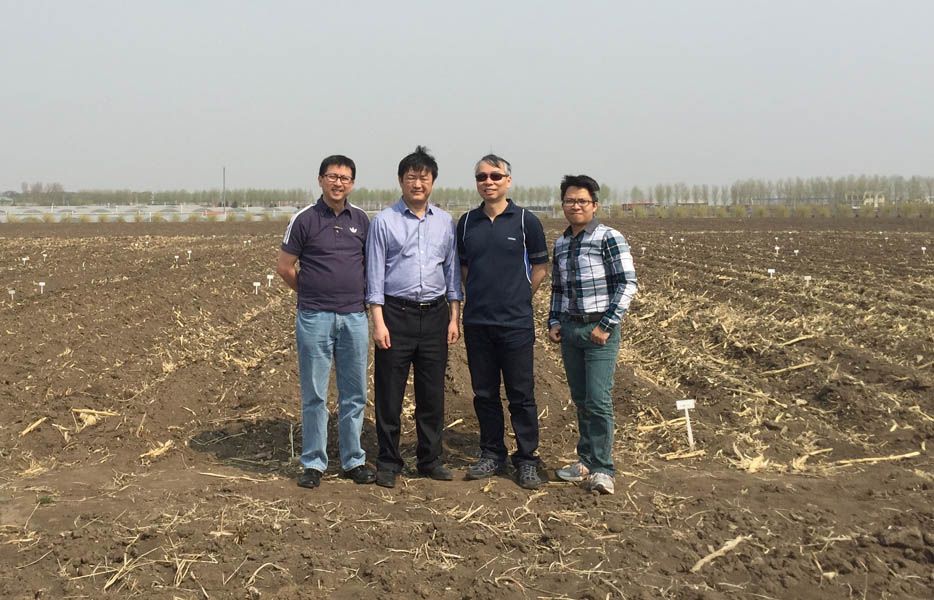
Prof. Amos P. K. Tai of the Earth System Science Programme teamed up with Prof. Hon-ming Lam of the School of Life Sciences at The Chinese University of Hong Kong (CUHK) to investigate the feasibility of a total replacement of the traditional farming practice of monoculture with intercropping. Using advanced computer models, they found that intercropping enables higher productivity in crops with less synthetic fertilizers and hence reduces the air pollutants being volatilized from the cropland soil. This sustainable farming practice may help maintain a stable food supply and mitigate the air pollution problem in China. These research findings have been published in the internationally renowned scientific journal Environmental Research Letters recently.
Food crisis and solutions
Fast-growing population and increasing trends of meal-inclined dietary habits will lead to an almost doubled food demand by 2050 as predicted by the United Nations. To satisfy such demand, humans must boost agricultural productivity but intensifying farming of either crops or animals can have serious impacts on the environment. These negative influences can be seen in the damaged habitats and biodiversity from deforestation for farmland expansion, soil degradation caused by over-planting, and the volatile ammonia in the atmosphere emitted from the excessive amount of fertilizer on cropland.
In China, around 95% of atmospheric ammonia pollutants are attributable to agricultural emissions. This ammonia reacts with other acidic air polluting chemicals, such as sulphur dioxide and nitrates, and forms fine particulate matters, which are the major cause of photochemical smog. It doesn’t only lower visibility but also has harmful effects on human’s circulation and respiratory systems. Long exposure to a high concentration can also lead to premature death. Studies have shown that, by 2050, agricultural ammonia emission could have risen by at least 10% from now. Without proper controls, boosting productivity could end up threatening the environment and our health.
The research team noticed that a number of Chinese farmers have taken advantage of the nitrogen-fixing properties of legumes, e.g., soybean, by intercropping them with non-legume plants; sowing them in between those non-legume plants which are already growing in the farm. They intend to let these crops compete for soil nutrients to speed up the biological process of nitrogen-fixing carried by the legume, converting more atmospheric nitrogen into ammonium as an extra supply of soil nutrients. This natural supply of soil nitrogen can allow less synthetic input by the farmers. Despite the advantages, such intercropping practice requires multiple sowing and harvesting exercises and involves more labour. Together with the rise in labour cost due to urbanisation, the adoption rate of intercropping in Chinese cropland has dropped significantly. Realising this situation, the team decided to look closer into the costs and benefits of intercropping, hoping to find a suitable alternative to the traditional farming practice as a way out of the food crisis.
Intercropping as a potential way to tackle the food crisis on a national level in China and maybe even on a global level
The team started this study by improving a computer model, DeNitrification-DeComposition (DNDC), to compare intercropping and monocultural of maize and soybean for their crop yields, amounts of fertilizer use, and ammonia emitted. Simulations were conducted under the same meteorological conditions, soil properties, and farming practices as the testing conditions of a field experiment conducted by a collaborator in Sichuan Agricultural University.
Using this model, the team predicts what would happen if such a maize (non-legume) – soybean (legumes) intercropping system is adopted in all maize and soybean croplands over every Chinese province. The results show that, on the cropland which was originally for maize or soybean only, intercropping could produce the same quantity of maize (4,300–16,000 kilograms per hectare) and an additional batch of soybean (2,800–5,000 kilograms per hectare), but with 42% less fertilizer requirement.
In addition to such a productivity rise and the avoided fertilizer use, intercropping emitted less ammonia than monoculture by 45%. The team then fed these results into a 3-D atmospheric chemistry model, GEOS-Chem, to compute how such reduction in ammonia would impact on the formation of fine particulate matters over Chinese provinces. The model predicted that the annually averaged pollutant concentration could be lowered by up to 1.5 micrograms per cubic meter (or reduced by 2.3%). Improvement in air quality is seen mainly over the provinces in the Eastern and Northeastern China.
The study concluded with a cost-benefit of maize-soybean intercropping against the current farming practice for the two crops. Although additional labour and machinery might cost double, nationwide replacement of monoculture with intercropping could increase the annual national income by 67 billion US dollars, including 59 billion US dollars from the raised crop sales, and the avoided 13 billion US dollars in air pollution-related public health expenses.
Prof. Amos P. K. Tai said, “It showed that large scale adoption of intercropping could benefit the Chinese economy, the environment, and the health of the citizens. We hope this work can help demonstrate the use of a scientific framework to assist policymakers, governments, and other organisations around the globe in evaluating the potentials of various sustainable farming methods, and efficiently allocating their resources to alleviate the environmental and food supply issues in the foreseeable future.”
Note: Prof. Amos P.K. Tai and Prof. Hon-ming Lam each leads a WUN RDF project, namely “Impacts of Future Climate and Land Use Changes on Public Health and Food Security in Sub-Saharan Africa and Southeast Asia” and “Impacts of Grain Legume Research and Development in Developing Countries”, respectively.